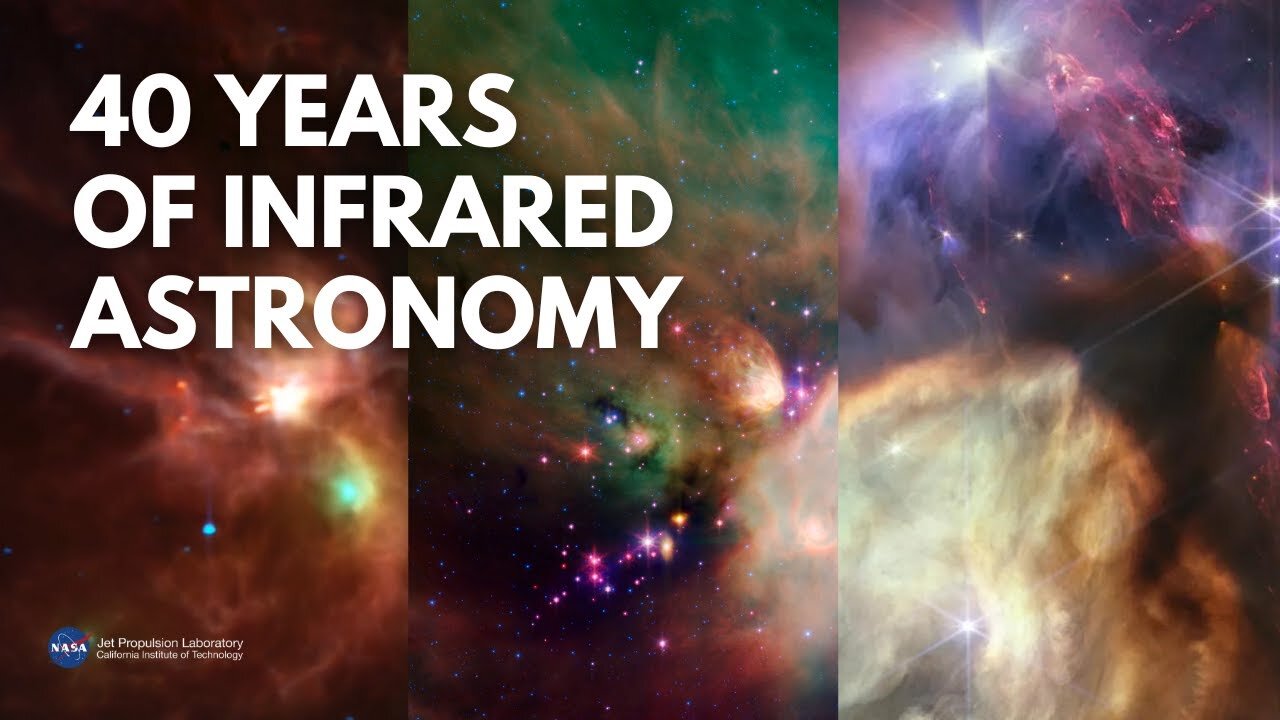Premium Only Content

NASA Telescopes Reveal an Invisible Infrared Universe
For 40 years, NASA has expanded our view of the universe with space telescopes that detect infrared light, which is invisible to the human eye. Observing the infrared realm helps us study the origins of planets, stars, galaxies, and even the universe itself.
NASA’s James Webb Space Telescope is the agency’s latest infrared space telescope, adding new insights to targets first discovered and studied by infrared missions that came before it.
Infrared space telescope missions have built upon one another to reveal stars, galaxies, and all manner of cosmic objects with ever-increasing clarity. Here you will see images from the pioneering Infrared Astronomical Satellite (IRAS), launched in 1983, the Spitzer Space Telescope, launched in 2003, and the James Webb Space Telescope, which launched in 2021 and is sending back extremely detailed images today.
For more information about Webb, visit: https://www.nasa.gov/webb
For more information about Spitzer, visit: https://www.nasa.gov/spitzer
For more information about IRAS, visit: https://www.jpl.nasa.gov/missions/inf...
Credits: IRAS images: NASA/Netherlands Agency for Aerospace Programmes/UK Science and Engineering Research Council/JPL-Caltech; Spitzer images: NASA/JPL-Caltech/IPAC; Webb images: NASA/ESA/CSA/STScI
For 40 years, NASA has expanded our view of the universe with space telescopes that detect infrared light, which is invisible to the human eye. Observing the infrared realm helps us study the origins of planets, stars, galaxies, and even the universe itself.
NASA’s James Webb Space Telescope is the agency’s latest infrared space telescope, adding new insights to targets first discovered and studied by infrared missions that came before it.
Infrared space telescope missions have built upon one another to reveal stars, galaxies, and all manner of cosmic objects with ever-increasing clarity. Here you will see images from the pioneering Infrared Astronomical Satellite (IRAS), launched in 1983, the Spitzer Space Telescope, launched in 2003, and the James Webb Space Telescope, which launched in 2021 and is sending back extremely detailed images today.
For more information about Webb, visit: https://www.nasa.gov/webb
For more information about Spitzer, visit: https://www.nasa.gov/spitzer
For more information about IRAS, visit: https://www.jpl.nasa.gov/missions/inf...
Credits: IRAS images: NASA/Netherlands Agency for Aerospace Programmes/UK Science and Engineering Research Council/JPL-Caltech; Spitzer images: NASA/JPL-Caltech/IPAC; Webb images: NASA/ESA/CSA/STScI
For 40 years, NASA has expanded our view of the universe with space telescopes that detect infrared light, which is invisible to the human eye. Observing the infrared realm helps us study the origins of planets, stars, galaxies, and even the universe itself.
NASA’s James Webb Space Telescope is the agency’s latest infrared space telescope, adding new insights to targets first discovered and studied by infrared missions that came before it.
Infrared space telescope missions have built upon one another to reveal stars, galaxies, and all manner of cosmic objects with ever-increasing clarity. Here you will see images from the pioneering Infrared Astronomical Satellite (IRAS), launched in 1983, the Spitzer Space Telescope, launched in 2003, and the James Webb Space Telescope, which launched in 2021 and is sending back extremely detailed images today.
For more information about Webb, visit: https://www.nasa.gov/webb
For more information about Spitzer, visit: https://www.nasa.gov/spitzer
For more information about IRAS, visit: https://www.jpl.nasa.gov/missions/inf...
Credits: IRAS images: NASA/Netherlands Agency for Aerospace Programmes/UK Science and Engineering Research Council/JPL-Caltech; Spitzer images: NASA/JPL-Caltech/IPAC; Webb images: NASA/ESA/CSA/STScI
For 40 years, NASA has expanded our view of the universe with space telescopes that detect infrared light, which is invisible to the human eye. Observing the infrared realm helps us study the origins of planets, stars, galaxies, and even the universe itself.
NASA’s James Webb Space Telescope is the agency’s latest infrared space telescope, adding new insights to targets first discovered and studied by infrared missions that came before it.
Infrared space telescope missions have built upon one another to reveal stars, galaxies, and all manner of cosmic objects with ever-increasing clarity. Here you will see images from the pioneering Infrared Astronomical Satellite (IRAS), launched in 1983, the Spitzer Space Telescope, launched in 2003, and the James Webb Space Telescope, which launched in 2021 and is sending back extremely detailed images today.
For more information about Webb, visit: https://www.nasa.gov/webb
For more information about Spitzer, visit: https://www.nasa.gov/spitzer
For more information about IRAS, visit: https://www.jpl.nasa.gov/missions/inf...
Credits: IRAS images: NASA/Netherlands Agency for Aerospace Programmes/UK Science and Engineering Research Council/JPL-Caltech; Spitzer images: NASA/JPL-Caltech/IPAC; Webb images: NASA/ESA/CSA/STScI
For 40 years, NASA has expanded our view of the universe with space telescopes that detect infrared light, which is invisible to the human eye. Observing the infrared realm helps us study the origins of planets, stars, galaxies, and even the universe itself.
NASA’s James Webb Space Telescope is the agency’s latest infrared space telescope, adding new insights to targets first discovered and studied by infrared missions that came before it.
Infrared space telescope missions have built upon one another to reveal stars, galaxies, and all manner of cosmic objects with ever-increasing clarity. Here you will see images from the pioneering Infrared Astronomical Satellite (IRAS), launched in 1983, the Spitzer Space Telescope, launched in 2003, and the James Webb Space Telescope, which launched in 2021 and is sending back extremely detailed images today.
For more information about Webb, visit: https://www.nasa.gov/webb
For more information about Spitzer, visit: https://www.nasa.gov/spitzer
For more information about IRAS, visit: https://www.jpl.nasa.gov/missions/inf...
Credits: IRAS images: NASA/Netherlands Agency for Aerospace Programmes/UK Science and Engineering Research Council/JPL-Caltech; Spitzer images: NASA/JPL-Caltech/IPAC; Webb images: NASA/ESA/CSA/STScI
For 40 years, NASA has expanded our view of the universe with space telescopes that detect infrared light, which is invisible to the human eye. Observing the infrared realm helps us study the origins of planets, stars, galaxies, and even the universe itself.
NASA’s James Webb Space Telescope is the agency’s latest infrared space telescope, adding new insights to targets first discovered and studied by infrared missions that came before it.
Infrared space telescope missions have built upon one another to reveal stars, galaxies, and all manner of cosmic objects with ever-increasing clarity. Here you will see images from the pioneering Infrared Astronomical Satellite (IRAS), launched in 1983, the Spitzer Space Telescope, launched in 2003, and the James Webb Space Telescope, which launched in 2021 and is sending back extremely detailed images today.
For more information about Webb, visit: https://www.nasa.gov/webb
For more information about Spitzer, visit: https://www.nasa.gov/spitzer
For more information about IRAS, visit: https://www.jpl.nasa.gov/missions/inf...
Credits: IRAS images: NASA/Netherlands Agency for Aerospace Programmes/UK Science and Engineering Research Council/JPL-Caltech; Spitzer images: NASA/JPL-Caltech/IPAC; Webb images: NASA/ESA/CSA/STScI
For 40 years, NASA has expanded our view of the universe with space telescopes that detect infrared light, which is invisible to the human eye. Observing the infrared realm helps us study the origins of planets, stars, galaxies, and even the universe itself.
NASA’s James Webb Space Telescope is the agency’s latest infrared space telescope, adding new insights to targets first discovered and studied by infrared missions that came before it.
Infrared space telescope missions have built upon one another to reveal stars, galaxies, and all manner of cosmic objects with ever-increasing clarity. Here you will see images from the pioneering Infrared Astronomical Satellite (IRAS), launched in 1983, the Spitzer Space Telescope, launched in 2003, and the James Webb Space Telescope, which launched in 2021 and is sending back extremely detailed images today.
For more information about Webb, visit: https://www.nasa.gov/webb
For more information about Spitzer, visit: https://www.nasa.gov/spitzer
For more information about IRAS, visit: https://www.jpl.nasa.gov/missions/inf...
Credits: IRAS images: NASA/Netherlands Agency for Aerospace Programmes/UK Science and Engineering Research Council/JPL-Caltech; Spitzer images: NASA/JPL-Caltech/IPAC; Webb images: NASA/ESA/CSA/STScI
For 40 years, NASA has expanded our view of the universe with space telescopes that detect infrared light, which is invisible to the human eye. Observing the infrared realm helps us study the origins of planets, stars, galaxies, and even the universe itself.
NASA’s James Webb Space Telescope is the agency’s latest infrared space telescope, adding new insights to targets first discovered and studied by infrared missions that came before it.
Infrared space telescope missions have built upon one another to reveal stars, galaxies, and all manner of cosmic objects with ever-increasing clarity. Here you will see images from the pioneering Infrared Astronomical Satellite (IRAS), launched in 1983, the Spitzer Space Telescope, launched in 2003, and the James Webb Space Telescope, which launched in 2021 and is sending back extremely detailed images today.
For more information about Webb, visit: https://www.nasa.gov/webb
For more information about Spitzer, visit: https://www.nasa.gov/spitzer
For more information about IRAS, visit: https://www.jpl.nasa.gov/missions/inf...
Credits: IRAS images: NASA/Netherlands Agency for Aerospace Programmes/UK Science and Engineering Research Council/JPL-Caltech; Spitzer images: NASA/JPL-Caltech/IPAC; Webb images: NASA/ESA/CSA/STScI
For 40 years, NASA has expanded our view of the universe with space telescopes that detect infrared light, which is invisible to the human eye. Observing the infrared realm helps us study the origins of planets, stars, galaxies, and even the universe itself.
NASA’s James Webb Space Telescope is the agency’s latest infrared space telescope, adding new insights to targets first discovered and studied by infrared missions that came before it.
Infrared space telescope missions have built upon one another to reveal stars, galaxies, and all manner of cosmic objects with ever-increasing clarity. Here you will see images from the pioneering Infrared Astronomical Satellite (IRAS), launched in 1983, the Spitzer Space Telescope, launched in 2003, and the James Webb Space Telescope, which launched in 2021 and is sending back extremely detailed images today.
For more information about Webb, visit: https://www.nasa.gov/webb
For more information about Spitzer, visit: https://www.nasa.gov/spitzer
For more information about IRAS, visit: https://www.jpl.nasa.gov/missions/inf...
Credits: IRAS images: NASA/Netherlands Agency for Aerospace Programmes/UK Science and Engineering Research Council/JPL-Caltech; Spitzer images: NASA/JPL-Caltech/IPAC; Webb images: NASA/ESA/CSA/STScI
For 40 years, NASA has expanded our view of the universe with space telescopes that detect infrared light, which is invisible to the human eye. Observing the infrared realm helps us study the origins of planets, stars, galaxies, and even the universe itself.
NASA’s James Webb Space Telescope is the agency’s latest infrared space telescope, adding new insights to targets first discovered and studied by infrared missions that came before it.
Infrared space telescope missions have built upon one another to reveal stars, galaxies, and all manner of cosmic objects with ever-increasing clarity. Here you will see images from the pioneering Infrared Astronomical Satellite (IRAS), launched in 1983, the Spitzer Space Telescope, launched in 2003, and the James Webb Space Telescope, which launched in 2021 and is sending back extremely detailed images today.
For more information about Webb, visit: https://www.nasa.gov/webb
For more information about Spitzer, visit: https://www.nasa.gov/spitzer
For more information about IRAS, visit: https://www.jpl.nasa.gov/missions/inf...
Credits: IRAS images: NASA/Netherlands Agency for Aerospace Programmes/UK Science and Engineering Research Council/JPL-Caltech; Spitzer images: NASA/JPL-Caltech/IPAC; Webb images: NASA/ESA/CSA/STScI
For 40 years, NASA has expanded our view of the universe with space telescopes that detect infrared light, which is invisible to the human eye. Observing the infrared realm helps us study the origins of planets, stars, galaxies, and even the universe itself.
NASA’s James Webb Space Telescope is the agency’s latest infrared space telescope, adding new insights to targets first discovered and studied by infrared missions that came before it.
Infrared space telescope missions have built upon one another to reveal stars, galaxies, and all manner of cosmic objects with ever-increasing clarity. Here you will see images from the pioneering Infrared Astronomical Satellite (IRAS), launched in 1983, the Spitzer Space Telescope, launched in 2003, and the James Webb Space Telescope, which launched in 2021 and is sending back extremely detailed images today.
For more information about Webb, visit: https://www.nasa.gov/webb
For more information about Spitzer, visit: https://www.nasa.gov/spitzer
For more information about IRAS, visit: https://www.jpl.nasa.gov/missions/inf...
Credits: IRAS images: NASA/Netherlands Agency for Aerospace Programmes/UK Science and Engineering Research Council/JPL-Caltech; Spitzer images: NASA/JPL-Caltech/IPAC; Webb images: NASA/ESA/CSA/STScI
For 40 years, NASA has expanded our view of the universe with space telescopes that detect infrared light, which is invisible to the human eye. Observing the infrared realm helps us study the origins of planets, stars, galaxies, and even the universe itself.
NASA’s James Webb Space Telescope is the agency’s latest infrared space telescope, adding new insights to targets first discovered and studied by infrared missions that came before it.
Infrared space telescope missions have built upon one another to reveal stars, galaxies, and all manner of cosmic objects with ever-increasing clarity. Here you will see images from the pioneering Infrared Astronomical Satellite (IRAS), launched in 1983, the Spitzer Space Telescope, launched in 2003, and the James Webb Space Telescope, which launched in 2021 and is sending back extremely detailed images today.
For more information about Webb, visit: https://www.nasa.gov/webb
For more information about Spitzer, visit: https://www.nasa.gov/spitzer
For more information about IRAS, visit: https://www.jpl.nasa.gov/missions/inf...
Credits: IRAS images: NASA/Netherlands Agency for Aerospace Programmes/UK Science and Engineering Research Council/JPL-Caltech; Spitzer images: NASA/JPL-Caltech/IPAC; Webb images: NASA/ESA/CSA/STScI
For 40 years, NASA has expanded our view of the universe with space telescopes that detect infrared light, which is invisible to the human eye. Observing the infrared realm helps us study the origins of planets, stars, galaxies, and even the universe itself.
NASA’s James Webb Space Telescope is the agency’s latest infrared space telescope, adding new insights to targets first discovered and studied by infrared missions that came before it.
Infrared space telescope missions have built upon one another to reveal stars, galaxies, and all manner of cosmic objects with ever-increasing clarity. Here you will see images from the pioneering Infrared Astronomical Satellite (IRAS), launched in 1983, the Spitzer Space Telescope, launched in 2003, and the James Webb Space Telescope, which launched in 2021 and is sending back extremely detailed images today.
For more information about Webb, visit: https://www.nasa.gov/webb
For more information about Spitzer, visit: https://www.nasa.gov/spitzer
For more information about IRAS, visit: https://www.jpl.nasa.gov/missions/inf...
Credits: IRAS images: NASA/Netherlands Agency for Aerospace Programmes/UK Science and Engineering Research Council/JPL-Caltech; Spitzer images: NASA/JPL-Caltech/IPAC; Webb images: NASA/ESA/CSA/STScI
For 40 years, NASA has expanded our view of the universe with space telescopes that detect infrared light, which is invisible to the human eye. Observing the infrared realm helps us study the origins of planets, stars, galaxies, and even the universe itself.
NASA’s James Webb Space Telescope is the agency’s latest infrared space telescope, adding new insights to targets first discovered and studied by infrared missions that came before it.
Infrared space telescope missions have built upon one another to reveal stars, galaxies, and all manner of cosmic objects with ever-increasing clarity. Here you will see images from the pioneering Infrared Astronomical Satellite (IRAS), launched in 1983, the Spitzer Space Telescope, launched in 2003, and the James Webb Space Telescope, which launched in 2021 and is sending back extremely detailed images today.
For more information about Webb, visit: https://www.nasa.gov/webb
For more information about Spitzer, visit: https://www.nasa.gov/spitzer
For more information about IRAS, visit: https://www.jpl.nasa.gov/missions/inf...
Credits: IRAS images: NASA/Netherlands Agency for Aerospace Programmes/UK Science and Engineering Research Council/JPL-Caltech; Spitzer images: NASA/JPL-Caltech/IPAC; Webb images: NASA/ESA/CSA/STScI
For 40 years, NASA has expanded our view of the universe with space telescopes that detect infrared light, which is invisible to the human eye. Observing the infrared realm helps us study the origins of planets, stars, galaxies, and even the universe itself.
NASA’s James Webb Space Telescope is the agency’s latest infrared space telescope, adding new insights to targets first discovered and studied by infrared missions that came before it.
Infrared space telescope missions have built upon one another to reveal stars, galaxies, and all manner of cosmic objects with ever-increasing clarity. Here you will see images from the pioneering Infrared Astronomical Satellite (IRAS), launched in 1983, the Spitzer Space Telescope, launched in 2003, and the James Webb Space Telescope, which launched in 2021 and is sending back extremely detailed images today.
For more information about Webb, visit: https://www.nasa.gov/webb
For more information about Spitzer, visit: https://www.nasa.gov/spitzer
For more information about IRAS, visit: https://www.jpl.nasa.gov/missions/inf...
Credits: IRAS images: NASA/Netherlands Agency for Aerospace Programmes/UK Science and Engineering Research Council/JPL-Caltech; Spitzer images: NASA/JPL-Caltech/IPAC; Webb images: NASA/ESA/CSA/STScI
For 40 years, NASA has expanded our view of the universe with space telescopes that detect infrared light, which is invisible to the human eye. Observing the infrared realm helps us study the origins of planets, stars, galaxies, and even the universe itself.
NASA’s James Webb Space Telescope is the agency’s latest infrared space telescope, adding new insights to targets first discovered and studied by infrared missions that came before it.
Infrared space telescope missions have built upon one another to reveal stars, galaxies, and all manner of cosmic objects with ever-increasing clarity. Here you will see images from the pioneering Infrared Astronomical Satellite (IRAS), launched in 1983, the Spitzer Space Telescope, launched in 2003, and the James Webb Space Telescope, which launched in 2021 and is sending back extremely detailed images today.
For more information about Webb, visit: https://www.nasa.gov/webb
For more information about Spitzer, visit: https://www.nasa.gov/spitzer
For more information about IRAS, visit: https://www.jpl.nasa.gov/missions/inf...
Credits: IRAS images: NASA/Netherlands Agency for Aerospace Programmes/UK Science and Engineering Research Council/JPL-Caltech; Spitzer images: NASA/JPL-Caltech/IPAC; Webb images: NASA/ESA/CSA/STScI
For 40 years, NASA has expanded our view of the universe with space telescopes that detect infrared light, which is invisible to the human eye. Observing the infrared realm helps us study the origins of planets, stars, galaxies, and even the universe itself.
NASA’s James Webb Space Telescope is the agency’s latest infrared space telescope, adding new insights to targets first discovered and studied by infrared missions that came before it.
Infrared space telescope missions have built upon one another to reveal stars, galaxies, and all manner of cosmic objects with ever-increasing clarity. Here you will see images from the pioneering Infrared Astronomical Satellite (IRAS), launched in 1983, the Spitzer Space Telescope, launched in 2003, and the James Webb Space Telescope, which launched in 2021 and is sending back extremely detailed images today.
For more information about Webb, visit: https://www.nasa.gov/webb
For more information about Spitzer, visit: https://www.nasa.gov/spitzer
For more information about IRAS, visit: https://www.jpl.nasa.gov/missions/inf...
Credits: IRAS images: NASA/Netherlands Agency for Aerospace Programmes/UK Science and Engineering Research Council/JPL-Caltech; Spitzer images: NASA/JPL-Caltech/IPAC; Webb images: NASA/ESA/CSA/STScI
For 40 years, NASA has expanded our view of the universe with space telescopes that detect infrared light, which is invisible to the human eye. Observing the infrared realm helps us study the origins of planets, stars, galaxies, and even the universe itself.
NASA’s James Webb Space Telescope is the agency’s latest infrared space telescope, adding new insights to targets first discovered and studied by infrared missions that came before it.
Infrared space telescope missions have built upon one another to reveal stars, galaxies, and all manner of cosmic objects with ever-increasing clarity. Here you will see images from the pioneering Infrared Astronomical Satellite (IRAS), launched in 1983, the Spitzer Space Telescope, launched in 2003, and the James Webb Space Telescope, which launched in 2021 and is sending back extremely detailed images today.
For more information about Webb, visit: https://www.nasa.gov/webb
For more information about Spitzer, visit: https://www.nasa.gov/spitzer
For more information about IRAS, visit: https://www.jpl.nasa.gov/missions/inf...
Credits: IRAS images: NASA/Netherlands Agency for Aerospace Programmes/UK Science and Engineering Research Council/JPL-Caltech; Spitzer images: NASA/JPL-Caltech/IPAC; Webb images: NASA/ESA/CSA/STScI
For 40 years, NASA has expanded our view of the universe with space telescopes that detect infrared light, which is invisible to the human eye. Observing the infrared realm helps us study the origins of planets, stars, galaxies, and even the universe itself.
NASA’s James Webb Space Telescope is the agency’s latest infrared space telescope, adding new insights to targets first discovered and studied by infrared missions that came before it.
Infrared space telescope missions have built upon one another to reveal stars, galaxies, and all manner of cosmic objects with ever-increasing clarity. Here you will see images from the pioneering Infrared Astronomical Satellite (IRAS), launched in 1983, the Spitzer Space Telescope, launched in 2003, and the James Webb Space Telescope, which launched in 2021 and is sending back extremely detailed images today.
For more information about Webb, visit: https://www.nasa.gov/webb
For more information about Spitzer, visit: https://www.nasa.gov/spitzer
For more information about IRAS, visit: https://www.jpl.nasa.gov/missions/inf...
Credits: IRAS images: NASA/Netherlands Agency for Aerospace Programmes/UK Science and Engineering Research Council/JPL-Caltech; Spitzer images: NASA/JPL-Caltech/IPAC; Webb images: NASA/ESA/CSA/STScI
For 40 years, NASA has expanded our view of the universe with space telescopes that detect infrared light, which is invisible to the human eye. Observing the infrared realm helps us study the origins of planets, stars, galaxies, and even the universe itself.
NASA’s James Webb Space Telescope is the agency’s latest infrared space telescope, adding new insights to targets first discovered and studied by infrared missions that came before it.
Infrared space telescope missions have built upon one another to reveal stars, galaxies, and all manner of cosmic objects with ever-increasing clarity. Here you will see images from the pioneering Infrared Astronomical Satellite (IRAS), launched in 1983, the Spitzer Space Telescope, launched in 2003, and the James Webb Space Telescope, which launched in 2021 and is sending back extremely detailed images today.
For more information about Webb, visit: https://www.nasa.gov/webb
For more information about Spitzer, visit: https://www.nasa.gov/spitzer
For more information about IRAS, visit: https://www.jpl.nasa.gov/missions/inf...
Credits: IRAS images: NASA/Netherlands Agency for Aerospace Programmes/UK Science and Engineering Research Council/JPL-Caltech; Spitzer images: NASA/JPL-Caltech/IPAC; Webb images: NASA/ESA/CSA/STScI
For 40 years, NASA has expanded our view of the universe with space telescopes that detect infrared light, which is invisible to the human eye. Observing the infrared realm helps us study the origins of planets, stars, galaxies, and even the universe itself.
NASA’s James Webb Space Telescope is the agency’s latest infrared space telescope, adding new insights to targets first discovered and studied by infrared missions that came before it.
Infrared space telescope missions have built upon one another to reveal stars, galaxies, and all manner of cosmic objects with ever-increasing clarity. Here you will see images from the pioneering Infrared Astronomical Satellite (IRAS), launched in 1983, the Spitzer Space Telescope, launched in 2003, and the James Webb Space Telescope, which launched in 2021 and is sending back extremely detailed images today.
For more information about Webb, visit: https://www.nasa.gov/webb
For more information about Spitzer, visit: https://www.nasa.gov/spitzer
For more information about IRAS, visit: https://www.jpl.nasa.gov/missions/inf...
Credits: IRAS images: NASA/Netherlands Agency for Aerospace Programmes/UK Science and Engineering Research Council/JPL-Caltech; Spitzer images: NASA/JPL-Caltech/IPAC; Webb images: NASA/ESA/CSA/STScI
For 40 years, NASA has expanded our view of the universe with space telescopes that detect infrared light, which is invisible to the human eye. Observing the infrared realm helps us study the origins of planets, stars, galaxies, and even the universe itself.
NASA’s James Webb Space Telescope is the agency’s latest infrared space telescope, adding new insights to targets first discovered and studied by infrared missions that came before it.
Infrared space telescope missions have built upon one another to reveal stars, galaxies, and all manner of cosmic objects with ever-increasing clarity. Here you will see images from the pioneering Infrared Astronomical Satellite (IRAS), launched in 1983, the Spitzer Space Telescope, launched in 2003, and the James Webb Space Telescope, which launched in 2021 and is sending back extremely detailed images today.
For more information about Webb, visit: https://www.nasa.gov/webb
For more information about Spitzer, visit: https://www.nasa.gov/spitzer
For more information about IRAS, visit: https://www.jpl.nasa.gov/missions/inf...
Credits: IRAS images: NASA/Netherlands Agency for Aerospace Programmes/UK Science and Engineering Research Council/JPL-Caltech; Spitzer images: NASA/JPL-Caltech/IPAC; Webb images: NASA/ESA/CSA/STScI
For 40 years, NASA has expanded our view of the universe with space telescopes that detect infrared light, which is invisible to the human eye. Observing the infrared realm helps us study the origins of planets, stars, galaxies, and even the universe itself.
NASA’s James Webb Space Telescope is the agency’s latest infrared space telescope, adding new insights to targets first discovered and studied by infrared missions that came before it.
Infrared space telescope missions have built upon one another to reveal stars, galaxies, and all manner of cosmic objects with ever-increasing clarity. Here you will see images from the pioneering Infrared Astronomical Satellite (IRAS), launched in 1983, the Spitzer Space Telescope, launched in 2003, and the James Webb Space Telescope, which launched in 2021 and is sending back extremely detailed images today.
For more information about Webb, visit: https://www.nasa.gov/webb
For more information about Spitzer, visit: https://www.nasa.gov/spitzer
For more information about IRAS, visit: https://www.jpl.nasa.gov/missions/inf...
Credits: IRAS images: NASA/Netherlands Agency for Aerospace Programmes/UK Science and Engineering Research Council/JPL-Caltech; Spitzer images: NASA/JPL-Caltech/IPAC; Webb images: NASA/ESA/CSA/STScI
For 40 years, NASA has expanded our view of the universe with space telescopes that detect infrared light, which is invisible to the human eye. Observing the infrared realm helps us study the origins of planets, stars, galaxies, and even the universe itself.
NASA’s James Webb Space Telescope is the agency’s latest infrared space telescope, adding new insights to targets first discovered and studied by infrared missions that came before it.
Infrared space telescope missions have built upon one another to reveal stars, galaxies, and all manner of cosmic objects with ever-increasing clarity. Here you will see images from the pioneering Infrared Astronomical Satellite (IRAS), launched in 1983, the Spitzer Space Telescope, launched in 2003, and the James Webb Space Telescope, which launched in 2021 and is sending back extremely detailed images today.
For more information about Webb, visit: https://www.nasa.gov/webb
For more information about Spitzer, visit: https://www.nasa.gov/spitzer
For more information about IRAS, visit: https://www.jpl.nasa.gov/missions/inf...
Credits: IRAS images: NASA/Netherlands Agency for Aerospace Programmes/UK Science and Engineering Research Council/JPL-Caltech; Spitzer images: NASA/JPL-Caltech/IPAC; Webb images: NASA/ESA/CSA/STScI
For 40 years, NASA has expanded our view of the universe with space telescopes that detect infrared light, which is invisible to the human eye. Observing the infrared realm helps us study the origins of planets, stars, galaxies, and even the universe itself.
NASA’s James Webb Space Telescope is the agency’s latest infrared space telescope, adding new insights to targets first discovered and studied by infrared missions that came before it.
Infrared space telescope missions have built upon one another to reveal stars, galaxies, and all manner of cosmic objects with ever-increasing clarity. Here you will see images from the pioneering Infrared Astronomical Satellite (IRAS), launched in 1983, the Spitzer Space Telescope, launched in 2003, and the James Webb Space Telescope, which launched in 2021 and is sending back extremely detailed images today.
For more information about Webb, visit: https://www.nasa.gov/webb
For more information about Spitzer, visit: https://www.nasa.gov/spitzer
For more information about IRAS, visit: https://www.jpl.nasa.gov/missions/inf...
Credits: IRAS images: NASA/Netherlands Agency for Aerospace Programmes/UK Science and Engineering Research Council/JPL-Caltech; Spitzer images: NASA/JPL-Caltech/IPAC; Webb images: NASA/ESA/CSA/STScI
For 40 years, NASA has expanded our view of the universe with space telescopes that detect infrared light, which is invisible to the human eye. Observing the infrared realm helps us study the origins of planets, stars, galaxies, and even the universe itself.
NASA’s James Webb Space Telescope is the agency’s latest infrared space telescope, adding new insights to targets first discovered and studied by infrared missions that came before it.
Infrared space telescope missions have built upon one another to reveal stars, galaxies, and all manner of cosmic objects with ever-increasing clarity. Here you will see images from the pioneering Infrared Astronomical Satellite (IRAS), launched in 1983, the Spitzer Space Telescope, launched in 2003, and the James Webb Space Telescope, which launched in 2021 and is sending back extremely detailed images today.
For more information about Webb, visit: https://www.nasa.gov/webb
For more information about Spitzer, visit: https://www.nasa.gov/spitzer
For more information about IRAS, visit: https://www.jpl.nasa.gov/missions/inf...
Credits: IRAS images: NASA/Netherlands Agency for Aerospace Programmes/UK Science and Engineering Research Council/JPL-Caltech; Spitzer images: NASA/JPL-Caltech/IPAC; Webb images: NASA/ESA/CSA/STScI
For 40 years, NASA has expanded our view of the universe with space telescopes that detect infrared light, which is invisible to the human eye. Observing the infrared realm helps us study the origins of planets, stars, galaxies, and even the universe itself.
NASA’s James Webb Space Telescope is the agency’s latest infrared space telescope, adding new insights to targets first discovered and studied by infrared missions that came before it.
Infrared space telescope missions have built upon one another to reveal stars, galaxies, and all manner of cosmic objects with ever-increasing clarity. Here you will see images from the pioneering Infrared Astronomical Satellite (IRAS), launched in 1983, the Spitzer Space Telescope, launched in 2003, and the James Webb Space Telescope, which launched in 2021 and is sending back extremely detailed images today.
For more information about Webb, visit: https://www.nasa.gov/webb
For more information about Spitzer, visit: https://www.nasa.gov/spitzer
For more information about IRAS, visit: https://www.jpl.nasa.gov/missions/inf...
Credits: IRAS images: NASA/Netherlands Agency for Aerospace Programmes/UK Science and Engineering Research Council/JPL-Caltech; Spitzer images: NASA/JPL-Caltech/IPAC; Webb images: NASA/ESA/CSA/STScI
For 40 years, NASA has expanded our view of the universe with space telescopes that detect infrared light, which is invisible to the human eye. Observing the infrared realm helps us study the origins of planets, stars, galaxies, and even the universe itself.
NASA’s James Webb Space Telescope is the agency’s latest infrared space telescope, adding new insights to targets first discovered and studied by infrared missions that came before it.
Infrared space telescope missions have built upon one another to reveal stars, galaxies, and all manner of cosmic objects with ever-increasing clarity. Here you will see images from the pioneering Infrared Astronomical Satellite (IRAS), launched in 1983, the Spitzer Space Telescope, launched in 2003, and the James Webb Space Telescope, which launched in 2021 and is sending back extremely detailed images today.
For more information about Webb, visit: https://www.nasa.gov/webb
For more information about Spitzer, visit: https://www.nasa.gov/spitzer
For more information about IRAS, visit: https://www.jpl.nasa.gov/missions/inf...
Credits: IRAS images: NASA/Netherlands Agency for Aerospace Programmes/UK Science and Engineering Research Council/JPL-Caltech; Spitzer images: NASA/JPL-Caltech/IPAC; Webb images: NASA/ESA/CSA/STScI
For 40 years, NASA has expanded our view of the universe with space telescopes that detect infrared light, which is invisible to the human eye. Observing the infrared realm helps us study the origins of planets, stars, galaxies, and even the universe itself.
NASA’s James Webb Space Telescope is the agency’s latest infrared space telescope, adding new insights to targets first discovered and studied by infrared missions that came before it.
Infrared space telescope missions have built upon one another to reveal stars, galaxies, and all manner of cosmic objects with ever-increasing clarity. Here you will see images from the pioneering Infrared Astronomical Satellite (IRAS), launched in 1983, the Spitzer Space Telescope, launched in 2003, and the James Webb Space Telescope, which launched in 2021 and is sending back extremely detailed images today.
For more information about Webb, visit: https://www.nasa.gov/webb
For more information about Spitzer, visit: https://www.nasa.gov/spitzer
For more information about IRAS, visit: https://www.jpl.nasa.gov/missions/inf...
Credits: IRAS images: NASA/Netherlands Agency for Aerospace Programmes/UK Science and Engineering Research Council/JPL-Caltech; Spitzer images: NASA/JPL-Caltech/IPAC; Webb images: NASA/ESA/CSA/STScI
For 40 years, NASA has expanded our view of the universe with space telescopes that detect infrared light, which is invisible to the human eye. Observing the infrared realm helps us study the origins of planets, stars, galaxies, and even the universe itself.
NASA’s James Webb Space Telescope is the agency’s latest infrared space telescope, adding new insights to targets first discovered and studied by infrared missions that came before it.
Infrared space telescope missions have built upon one another to reveal stars, galaxies, and all manner of cosmic objects with ever-increasing clarity. Here you will see images from the pioneering Infrared Astronomical Satellite (IRAS), launched in 1983, the Spitzer Space Telescope, launched in 2003, and the James Webb Space Telescope, which launched in 2021 and is sending back extremely detailed images today.
For more information about Webb, visit: https://www.nasa.gov/webb
For more information about Spitzer, visit: https://www.nasa.gov/spitzer
For more information about IRAS, visit: https://www.jpl.nasa.gov/missions/inf...
Credits: IRAS images: NASA/Netherlands Agency for Aerospace Programmes/UK Science and Engineering Research Council/JPL-Caltech; Spitzer images: NASA/JPL-Caltech/IPAC; Webb images: NASA/ESA/CSA/STScI
For 40 years, NASA has expanded our view of the universe with space telescopes that detect infrared light, which is invisible to the human eye. Observing the infrared realm helps us study the origins of planets, stars, galaxies, and even the universe itself.
NASA’s James Webb Space Telescope is the agency’s latest infrared space telescope, adding new insights to targets first discovered and studied by infrared missions that came before it.
Infrared space telescope missions have built upon one another to reveal stars, galaxies, and all manner of cosmic objects with ever-increasing clarity. Here you will see images from the pioneering Infrared Astronomical Satellite (IRAS), launched in 1983, the Spitzer Space Telescope, launched in 2003, and the James Webb Space Telescope, which launched in 2021 and is sending back extremely detailed images today.
For more information about Webb, visit: https://www.nasa.gov/webb
For more information about Spitzer, visit: https://www.nasa.gov/spitzer
For more information about IRAS, visit: https://www.jpl.nasa.gov/missions/inf...
Credits: IRAS images: NASA/Netherlands Agency for Aerospace Programmes/UK Science and Engineering Research Council/JPL-Caltech; Spitzer images: NASA/JPL-Caltech/IPAC; Webb images: NASA/ESA/CSA/STScI
For 40 years, NASA has expanded our view of the universe with space telescopes that detect infrared light, which is invisible to the human eye. Observing the infrared realm helps us study the origins of planets, stars, galaxies, and even the universe itself.
NASA’s James Webb Space Telescope is the agency’s latest infrared space telescope, adding new insights to targets first discovered and studied by infrared missions that came before it.
Infrared space telescope missions have built upon one another to reveal stars, galaxies, and all manner of cosmic objects with ever-increasing clarity. Here you will see images from the pioneering Infrared Astronomical Satellite (IRAS), launched in 1983, the Spitzer Space Telescope, launched in 2003, and the James Webb Space Telescope, which launched in 2021 and is sending back extremely detailed images today.
For more information about Webb, visit: https://www.nasa.gov/webb
For more information about Spitzer, visit: https://www.nasa.gov/spitzer
For more information about IRAS, visit: https://www.jpl.nasa.gov/missions/inf...
Credits: IRAS images: NASA/Netherlands Agency for Aerospace Programmes/UK Science and Engineering Research Council/JPL-Caltech; Spitzer images: NASA/JPL-Caltech/IPAC; Webb images: NASA/ESA/CSA/STScI
For 40 years, NASA has expanded our view of the universe with space telescopes that detect infrared light, which is invisible to the human eye. Observing the infrared realm helps us study the origins of planets, stars, galaxies, and even the universe itself.
NASA’s James Webb Space Telescope is the agency’s latest infrared space telescope, adding new insights to targets first discovered and studied by infrared missions that came before it.
Infrared space telescope missions have built upon one another to reveal stars, galaxies, and all manner of cosmic objects with ever-increasing clarity. Here you will see images from the pioneering Infrared Astronomical Satellite (IRAS), launched in 1983, the Spitzer Space Telescope, launched in 2003, and the James Webb Space Telescope, which launched in 2021 and is sending back extremely detailed images today.
For more information about Webb, visit: https://www.nasa.gov/webb
For more information about Spitzer, visit: https://www.nasa.gov/spitzer
For more information about IRAS, visit: https://www.jpl.nasa.gov/missions/inf...
Credits: IRAS images: NASA/Netherlands Agency for Aerospace Programmes/UK Science and Engineering Research Council/JPL-Caltech; Spitzer images: NASA/JPL-Caltech/IPAC; Webb images: NASA/ESA/CSA/STScI
For 40 years, NASA has expanded our view of the universe with space telescopes that detect infrared light, which is invisible to the human eye. Observing the infrared realm helps us study the origins of planets, stars, galaxies, and even the universe itself.
NASA’s James Webb Space Telescope is the agency’s latest infrared space telescope, adding new insights to targets first discovered and studied by infrared missions that came before it.
Infrared space telescope missions have built upon one another to reveal stars, galaxies, and all manner of cosmic objects with ever-increasing clarity. Here you will see images from the pioneering Infrared Astronomical Satellite (IRAS), launched in 1983, the Spitzer Space Telescope, launched in 2003, and the James Webb Space Telescope, which launched in 2021 and is sending back extremely detailed images today.
For more information about Webb, visit: https://www.nasa.gov/webb
For more information about Spitzer, visit: https://www.nasa.gov/spitzer
For more information about IRAS, visit: https://www.jpl.nasa.gov/missions/inf...
Credits: IRAS images: NASA/Netherlands Agency for Aerospace Programmes/UK Science and Engineering Research Council/JPL-Caltech; Spitzer images: NASA/JPL-Caltech/IPAC; Webb images: NASA/ESA/CSA/STScI
For 40 years, NASA has expanded our view of the universe with space telescopes that detect infrared light, which is invisible to the human eye. Observing the infrared realm helps us study the origins of planets, stars, galaxies, and even the universe itself.
NASA’s James Webb Space Telescope is the agency’s latest infrared space telescope, adding new insights to targets first discovered and studied by infrared missions that came before it.
Infrared space telescope missions have built upon one another to reveal stars, galaxies, and all manner of cosmic objects with ever-increasing clarity. Here you will see images from the pioneering Infrared Astronomical Satellite (IRAS), launched in 1983, the Spitzer Space Telescope, launched in 2003, and the James Webb Space Telescope, which launched in 2021 and is sending back extremely detailed images today.
For more information about Webb, visit: https://www.nasa.gov/webb
For more information about Spitzer, visit: https://www.nasa.gov/spitzer
For more information about IRAS, visit: https://www.jpl.nasa.gov/missions/inf...
Credits: IRAS images: NASA/Netherlands Agency for Aerospace Programmes/UK Science and Engineering Research Council/JPL-Caltech; Spitzer images: NASA/JPL-Caltech/IPAC; Webb images: NASA/ESA/CSA/STScI
For 40 years, NASA has expanded our view of the universe with space telescopes that detect infrared light, which is invisible to the human eye. Observing the infrared realm helps us study the origins of planets, stars, galaxies, and even the universe itself.
NASA’s James Webb Space Telescope is the agency’s latest infrared space telescope, adding new insights to targets first discovered and studied by infrared missions that came before it.
Infrared space telescope missions have built upon one another to reveal stars, galaxies, and all manner of cosmic objects with ever-increasing clarity. Here you will see images from the pioneering Infrared Astronomical Satellite (IRAS), launched in 1983, the Spitzer Space Telescope, launched in 2003, and the James Webb Space Telescope, which launched in 2021 and is sending back extremely detailed images today.
For more information about Webb, visit: https://www.nasa.gov/webb
For more information about Spitzer, visit: https://www.nasa.gov/spitzer
For more information about IRAS, visit: https://www.jpl.nasa.gov/missions/inf...
Credits: IRAS images: NASA/Netherlands Agency for Aerospace Programmes/UK Science and Engineering Research Council/JPL-Caltech; Spitzer images: NASA/JPL-Caltech/IPAC; Webb images: NASA/ESA/CSA/STScI
For 40 years, NASA has expanded our view of the universe with space telescopes that detect infrared light, which is invisible to the human eye. Observing the infrared realm helps us study the origins of planets, stars, galaxies, and even the universe itself.
NASA’s James Webb Space Telescope is the agency’s latest infrared space telescope, adding new insights to targets first discovered and studied by infrared missions that came before it.
Infrared space telescope missions have built upon one another to reveal stars, galaxies, and all manner of cosmic objects with ever-increasing clarity. Here you will see images from the pioneering Infrared Astronomical Satellite (IRAS), launched in 1983, the Spitzer Space Telescope, launched in 2003, and the James Webb Space Telescope, which launched in 2021 and is sending back extremely detailed images today.
For more information about Webb, visit: https://www.nasa.gov/webb
For more information about Spitzer, visit: https://www.nasa.gov/spitzer
For more information about IRAS, visit: https://www.jpl.nasa.gov/missions/inf...
Credits: IRAS images: NASA/Netherlands Agency for Aerospace Programmes/UK Science and Engineering Research Council/JPL-Caltech; Spitzer images: NASA/JPL-Caltech/IPAC; Webb images: NASA/ESA/CSA/STScI
For 40 years, NASA has expanded our view of the universe with space telescopes that detect infrared light, which is invisible to the human eye. Observing the infrared realm helps us study the origins of planets, stars, galaxies, and even the universe itself.
NASA’s James Webb Space Telescope is the agency’s latest infrared space telescope, adding new insights to targets first discovered and studied by infrared missions that came before it.
Infrared space telescope missions have built upon one another to reveal stars, galaxies, and all manner of cosmic objects with ever-increasing clarity. Here you will see images from the pioneering Infrared Astronomical Satellite (IRAS), launched in 1983, the Spitzer Space Telescope, launched in 2003, and the James Webb Space Telescope, which launched in 2021 and is sending back extremely detailed images today.
For more information about Webb, visit: https://www.nasa.gov/webb
For more information about Spitzer, visit: https://www.nasa.gov/spitzer
For more information about IRAS, visit: https://www.jpl.nasa.gov/missions/inf...
Credits: IRAS images: NASA/Netherlands Agency for Aerospace Programmes/UK Science and Engineering Research Council/JPL-Caltech; Spitzer images: NASA/JPL-Caltech/IPAC; Webb images: NASA/ESA/CSA/STScI
For 40 years, NASA has expanded our view of the universe with space telescopes that detect infrared light, which is invisible to the human eye. Observing the infrared realm helps us study the origins of planets, stars, galaxies, and even the universe itself.
NASA’s James Webb Space Telescope is the agency’s latest infrared space telescope, adding new insights to targets first discovered and studied by infrared missions that came before it.
Infrared space telescope missions have built upon one another to reveal stars, galaxies, and all manner of cosmic objects with ever-increasing clarity. Here you will see images from the pioneering Infrared Astronomical Satellite (IRAS), launched in 1983, the Spitzer Space Telescope, launched in 2003, and the James Webb Space Telescope, which launched in 2021 and is sending back extremely detailed images today.
For more information about Webb, visit: https://www.nasa.gov/webb
For more information about Spitzer, visit: https://www.nasa.gov/spitzer
For more information about IRAS, visit: https://www.jpl.nasa.gov/missions/inf...
Credits: IRAS images: NASA/Netherlands Agency for Aerospace Programmes/UK Science and Engineering Research Council/JPL-Caltech; Spitzer images: NASA/JPL-Caltech/IPAC; Webb images: NASA/ESA/CSA/STScI
For 40 years, NASA has expanded our view of the universe with space telescopes that detect infrared light, which is invisible to the human eye. Observing the infrared realm helps us study the origins of planets, stars, galaxies, and even the universe itself.
NASA’s James Webb Space Telescope is the agency’s latest infrared space telescope, adding new insights to targets first discovered and studied by infrared missions that came before it.
Infrared space telescope missions have built upon one another to reveal stars, galaxies, and all manner of cosmic objects with ever-increasing clarity. Here you will see images from the pioneering Infrared Astronomical Satellite (IRAS), launched in 1983, the Spitzer Space Telescope, launched in 2003, and the James Webb Space Telescope, which launched in 2021 and is sending back extremely detailed images today.
For more information about Webb, visit: https://www.nasa.gov/webb
For more information about Spitzer, visit: https://www.nasa.gov/spitzer
For more information about IRAS, visit: https://www.jpl.nasa.gov/missions/inf...
Credits: IRAS images: NASA/Netherlands Agency for Aerospace Programmes/UK Science and Engineering Research Council/JPL-Caltech; Spitzer images: NASA/JPL-Caltech/IPAC; Webb images: NASA/ESA/CSA/STScI
For 40 years, NASA has expanded our view of the universe with space telescopes that detect infrared light, which is invisible to the human eye. Observing the infrared realm helps us study the origins of planets, stars, galaxies, and even the universe itself.
NASA’s James Webb Space Telescope is the agency’s latest infrared space telescope, adding new insights to targets first discovered and studied by infrared missions that came before it.
Infrared space telescope missions have built upon one another to reveal stars, galaxies, and all manner of cosmic objects with ever-increasing clarity. Here you will see images from the pioneering Infrared Astronomical Satellite (IRAS), launched in 1983, the Spitzer Space Telescope, launched in 2003, and the James Webb Space Telescope, which launched in 2021 and is sending back extremely detailed images today.
For more information about Webb, visit: https://www.nasa.gov/webb
For more information about Spitzer, visit: https://www.nasa.gov/spitzer
For more information about IRAS, visit: https://www.jpl.nasa.gov/missions/inf...
Credits: IRAS images: NASA/Netherlands Agency for Aerospace Programmes/UK Science and Engineering Research Council/JPL-Caltech; Spitzer images: NASA/JPL-Caltech/IPAC; Webb images: NASA/ESA/CSA/STScI
For 40 years, NASA has expanded our view of the universe with space telescopes that detect infrared light, which is invisible to the human eye. Observing the infrared realm helps us study the origins of planets, stars, galaxies, and even the universe itself.
NASA’s James Webb Space Telescope is the agency’s latest infrared space telescope, adding new insights to targets first discovered and studied by infrared missions that came before it.
Infrared space telescope missions have built upon one another to reveal stars, galaxies, and all manner of cosmic objects with ever-increasing clarity. Here you will see images from the pioneering Infrared Astronomical Satellite (IRAS), launched in 1983, the Spitzer Space Telescope, launched in 2003, and the James Webb Space Telescope, which launched in 2021 and is sending back extremely detailed images today.
For more information about Webb, visit: https://www.nasa.gov/webb
For more information about Spitzer, visit: https://www.nasa.gov/spitzer
For more information about IRAS, visit: https://www.jpl.nasa.gov/missions/inf...
Credits: IRAS images: NASA/Netherlands Agency for Aerospace Programmes/UK Science and Engineering Research Council/JPL-Caltech; Spitzer images: NASA/JPL-Caltech/IPAC; Webb images: NASA/ESA/CSA/STScI
For 40 years, NASA has expanded our view of the universe with space telescopes that detect infrared light, which is invisible to the human eye. Observing the infrared realm helps us study the origins of planets, stars, galaxies, and even the universe itself.
NASA’s James Webb Space Telescope is the agency’s latest infrared space telescope, adding new insights to targets first discovered and studied by infrared missions that came before it.
Infrared space telescope missions have built upon one another to reveal stars, galaxies, and all manner of cosmic objects with ever-increasing clarity. Here you will see images from the pioneering Infrared Astronomical Satellite (IRAS), launched in 1983, the Spitzer Space Telescope, launched in 2003, and the James Webb Space Telescope, which launched in 2021 and is sending back extremely detailed images today.
For more information about Webb, visit: https://www.nasa.gov/webb
For more information about Spitzer, visit: https://www.nasa.gov/spitzer
For more information about IRAS, visit: https://www.jpl.nasa.gov/missions/inf...
Credits: IRAS images: NASA/Netherlands Agency for Aerospace Programmes/UK Science and Engineering Research Council/JPL-Caltech; Spitzer images: NASA/JPL-Caltech/IPAC; Webb images: NASA/ESA/CSA/STScI
For 40 years, NASA has expanded our view of the universe with space telescopes that detect infrared light, which is invisible to the human eye. Observing the infrared realm helps us study the origins of planets, stars, galaxies, and even the universe itself.
NASA’s James Webb Space Telescope is the agency’s latest infrared space telescope, adding new insights to targets first discovered and studied by infrared missions that came before it.
Infrared space telescope missions have built upon one another to reveal stars, galaxies, and all manner of cosmic objects with ever-increasing clarity. Here you will see images from the pioneering Infrared Astronomical Satellite (IRAS), launched in 1983, the Spitzer Space Telescope, launched in 2003, and the James Webb Space Telescope, which launched in 2021 and is sending back extremely detailed images today.
For more information about Webb, visit: https://www.nasa.gov/webb
For more information about Spitzer, visit: https://www.nasa.gov/spitzer
For more information about IRAS, visit: https://www.jpl.nasa.gov/missions/inf...
Credits: IRAS images: NASA/Netherlands Agency for Aerospace Programmes/UK Science and Engineering Research Council/JPL-Caltech; Spitzer images: NASA/JPL-Caltech/IPAC; Webb images: NASA/ESA/CSA/STScI
For 40 years, NASA has expanded our view of the universe with space telescopes that detect infrared light, which is invisible to the human eye. Observing the infrared realm helps us study the origins of planets, stars, galaxies, and even the universe itself.
NASA’s James Webb Space Telescope is the agency’s latest infrared space telescope, adding new insights to targets first discovered and studied by infrared missions that came before it.
Infrared space telescope missions have built upon one another to reveal stars, galaxies, and all manner of cosmic objects with ever-increasing clarity. Here you will see images from the pioneering Infrared Astronomical Satellite (IRAS), launched in 1983, the Spitzer Space Telescope, launched in 2003, and the James Webb Space Telescope, which launched in 2021 and is sending back extremely detailed images today.
For more information about Webb, visit: https://www.nasa.gov/webb
For more information about Spitzer, visit: https://www.nasa.gov/spitzer
For more information about IRAS, visit: https://www.jpl.nasa.gov/missions/inf...
Credits: IRAS images: NASA/Netherlands Agency for Aerospace Programmes/UK Science and Engineering Research Council/JPL-Caltech; Spitzer images: NASA/JPL-Caltech/IPAC; Webb images: NASA/ESA/CSA/STScI
For 40 years, NASA has expanded our view of the universe with space telescopes that detect infrared light, which is invisible to the human eye. Observing the infrared realm helps us study the origins of planets, stars, galaxies, and even the universe itself.
NASA’s James Webb Space Telescope is the agency’s latest infrared space telescope, adding new insights to targets first discovered and studied by infrared missions that came before it.
Infrared space telescope missions have built upon one another to reveal stars, galaxies, and all manner of cosmic objects with ever-increasing clarity. Here you will see images from the pioneering Infrared Astronomical Satellite (IRAS), launched in 1983, the Spitzer Space Telescope, launched in 2003, and the James Webb Space Telescope, which launched in 2021 and is sending back extremely detailed images today.
For more information about Webb, visit: https://www.nasa.gov/webb
For more information about Spitzer, visit: https://www.nasa.gov/spitzer
For more information about IRAS, visit: https://www.jpl.nasa.gov/missions/inf...
Credits: IRAS images: NASA/Netherlands Agency for Aerospace Programmes/UK Science and Engineering Research Council/JPL-Caltech; Spitzer images: NASA/JPL-Caltech/IPAC; Webb images: NASA/ESA/CSA/STScI
For 40 years, NASA has expanded our view of the universe with space telescopes that detect infrared light, which is invisible to the human eye. Observing the infrared realm helps us study the origins of planets, stars, galaxies, and even the universe itself.
NASA’s James Webb Space Telescope is the agency’s latest infrared space telescope, adding new insights to targets first discovered and studied by infrared missions that came before it.
Infrared space telescope missions have built upon one another to reveal stars, galaxies, and all manner of cosmic objects with ever-increasing clarity. Here you will see images from the pioneering Infrared Astronomical Satellite (IRAS), launched in 1983, the Spitzer Space Telescope, launched in 2003, and the James Webb Space Telescope, which launched in 2021 and is sending back extremely detailed images today.
For more information about Webb, visit: https://www.nasa.gov/webb
For more information about Spitzer, visit: https://www.nasa.gov/spitzer
For more information about IRAS, visit: https://www.jpl.nasa.gov/missions/inf...
Credits: IRAS images: NASA/Netherlands Agency for Aerospace Programmes/UK Science and Engineering Research Council/JPL-Caltech; Spitzer images: NASA/JPL-Caltech/IPAC; Webb images: NASA/ESA/CSA/STScI
For 40 years, NASA has expanded our view of the universe with space telescopes that detect infrared light, which is invisible to the human eye. Observing the infrared realm helps us study the origins of planets, stars, galaxies, and even the universe itself.
NASA’s James Webb Space Telescope is the agency’s latest infrared space telescope, adding new insights to targets first discovered and studied by infrared missions that came before it.
Infrared space telescope missions have built upon one another to reveal stars, galaxies, and all manner of cosmic objects with ever-increasing clarity. Here you will see images from the pioneering Infrared Astronomical Satellite (IRAS), launched in 1983, the Spitzer Space Telescope, launched in 2003, and the James Webb Space Telescope, which launched in 2021 and is sending back extremely detailed images today.
For more information about Webb, visit: https://www.nasa.gov/webb
For more information about Spitzer, visit: https://www.nasa.gov/spitzer
For more information about IRAS, visit: https://www.jpl.nasa.gov/missions/inf...
Credits: IRAS images: NASA/Netherlands Agency for Aerospace Programmes/UK Science and Engineering Research Council/JPL-Caltech; Spitzer images: NASA/JPL-Caltech/IPAC; Webb images: NASA/ESA/CSA/STScI
-
 LIVE
LIVE
The Charlie Kirk Show
45 minutes agoIslam vs. America + The Future of Florida + Chaper Leaders Report | Enjeti, Rep. Donalds | 11.19.25
3,180 watching -

Nikko Ortiz
2 hours agoRage Baiting Is Real... | Rumble LIVE
10.1K -
 LIVE
LIVE
Steven Crowder
3 hours ago🔴 Epstein Release Watch: What Happens When Trump Signs
25,839 watching -
 56:05
56:05
The Rubin Report
1 hour agoDems Regret Epstein Files Release as Major Dem Names Come Out
18.7K45 -
 LIVE
LIVE
LFA TV
15 hours agoLIVE & BREAKING NEWS! | WEDNESDAY 11/19/25
3,832 watching -
 LIVE
LIVE
The Shannon Joy Show
1 hour ago“Quiet Piggy!” Trump Lashes Out At Reporter After Epstein Bill Passes Overwhelmingly In House!
234 watching -
 LIVE
LIVE
Grant Stinchfield
1 hour agoDOJ’s Salacious Distraction: The REAL Epstein Intel Is Locked in Langley!
111 watching -
 LIVE
LIVE
LadyDesireeMusic
2 hours agoLive Piano Music & Convo & Requests
128 watching -
 LIVE
LIVE
Trumpet Daily
1 hour agoTrumpet Daily LIVE | Nov. 19, 2025
356 watching -
 LIVE
LIVE
Viss
2 hours ago🔴LIVE - Pushing The Timer and Those in Our Path - Arc Raiders
149 watching